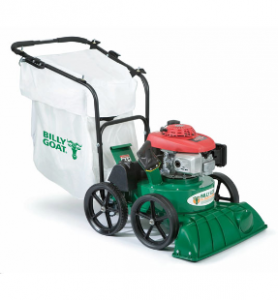Inevitably, the bag on your Billy Goat vacuum will need to be replaced, but it will last a lot longer with the proper care. Here’s what you need to know about cleaning, attaching and maintaining the bag to maintain your vacuum’s performance.
Bag Maintenance and its Effect on Performance
The bag on outdoor leaf and contractor vacuums works a lot like the bags found on indoor vacuums: air and dirt are sucked into the machine then pushed out through pores in the bag, trapping dirt along the way. As the vacuum is used, the fabric is saturated with dirt, while the addition of debris reduces the exposed area, limiting air flow. In turn, this reduces suction power, hampering performance.
When it comes to debris, Billy Goat recommends emptying the bag when it’s half full to ensure air flow. If the material is wet, it can’t be reduced as effectively by the impeller, so you should expect to empty the bag more frequently. The bag should also be rinsed off after each use, but more intensive cleaning may be needed occasionally to get rid of build-up.
Bag Break-In
A new bag can be used straight out of the package, but it will perform better if it’s given time to break in. This will open up the pores in the fabric and push the material into shape when loaded, letting it hold more and clog less frequently.
Breaking in a bag is simple: mount the bag to the vacuum, set the vacuum on a level surface that is free of dirt, such as a driveway, and start the engine. Set the motor to half throttle and let it run for a half hour.
If you’ve just washed the bag, it’s a good idea to go through this break-in process again to push out any remaining soap and debris while stretching out the bag fabric.
Bag Attachment and Removal
To install a bag, start by lifting the door on the vacuum and sliding the front opening of the bag down through the slot. Once seated, lock the four straps onto the handle, working front to back. Make sure the two clips on the bottom rear of the bag are closed.
When it’s time to empty the bag, shut off the engine and wait until the motor and impeller come to a complete stop. Unlatch the two clips on the bottom of the bag, then lift the bag and undo the straps, starting at the back and moving forward. Gripping the bag at the center will take the tension off of the straps and help push out some of the debris, making the bag lighter and easier to move. Finally, slide the opening up out of the vacuum and tilt the whole bag backward to dump out its contents.
Cleaning
After using the vacuum, remove the bag and turn it inside out to remove any clinging leaves and debris. Rinse off any dust left on the surface with a garden hose. Let the bag dry completely before using it again. If you’re cleaning several lawns a week, it’s a good idea to have a spare bag on hand so one can be on the vacuum while the other is drying.
Eventually, dirt build-up will clog the bag fabric, preventing airflow no matter how much debris is inside. At this point, the bag should be washed in water and a mild detergent. Wipe away debris and rinse the surface as usual before using soapy water, then rinse again before drying. Never uses a pressure washer, as it can damage the fabric.
Dealing with Excessive Dust During Operation
If you’re getting a coating of dust from the exiting air as you vacuum, it’s time to switch to a felt bag. This type of bag has finer pores to trap this dust, but as a result, it will clog up faster and require more frequent cleaning. This is usually an issue when vacuuming dry, fine soil and concrete dust.
Getting a Replacement Bag
Need a new bag, a different type of bag, or just want to keep an extra on hand so your vacuum is always ready to work? Billygoatparts.com offers parts and accessories for Billy Goat equipment as well as their manufacturing partners so you can get anything you need from bags to spark plugs. Our site uses factory descriptions and diagrams so you can quickly find the right part for your equipment, and we can ship your order anywhere in the U.S. or Canada.

